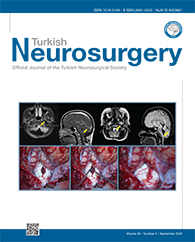2Linfen People?s Hospital, Department of Blood transfusion, Shanxi, China
3General Hospital of Ningxia Medical University, Department of Neurosurgery, Ningxia Hui Autonomous Region, China
4YongKang Hospital of Traditional Chinese Medicine, Department of Orthopaedics, Zhejiang, China
5General Hospital of Ningxia Medical University, Department of Spinal Surgery, Ningxia Hui Autonomous Region, China DOI : 10.5137/1019-5149.JTN.29010-20.2 AIM: To evaluate the association between in-hospital outcomes of patients with spinal tuberculosis and different surgical approaches.
MATERIAL and METHODS: This population-based, retrospective observational study analyzed data of hospitalized patients undergoing surgical treatment for spinal tuberculosis in the United States who were identified in the US Nationwide Inpatient Sample (NIS) between 2005 and 2014. The study cohort was stratified by posterior-only, anterior-only, and combined surgical approaches. Logistic and linear regression analyses were performed to evaluate associations between surgical approaches and patient outcomes.
RESULTS: Significant differences were found in postoperative complications, number of instrumented levels, and comorbidity scores (all p ? 0.033) between patients who received different surgical approaches. A univariate analysis demonstrated the combined approach was associated with significantly increased odds of postoperative complications compared with the posterior-only approach. This association remained significant when following multivariate analysis after adjustments. For patients who received surgery at the lumbosacral level, the anterior-only approach and combined approach were both associated with significantly increased odds of postoperative complications compared with the posterior-only approach. Among patients who received surgery at the lumbosacral level, multivariate analysis showed that anterior-only and combined approaches were associated with significantly longer length of stay.
CONCLUSION: Among patients with spinal tuberculosis who are undergoing surgical treatment, a posterior-only approach was associated with fewer complications and shorter length of stay compared with an anterior-only or combination approaches when performed at the lumbo-sacral spinal level.
Keywords : Spinal tuberculosis, Pott?s disease, Spinal fusion, Anterior approach, Posterior approach, National Inpatient Sample (NIS)




